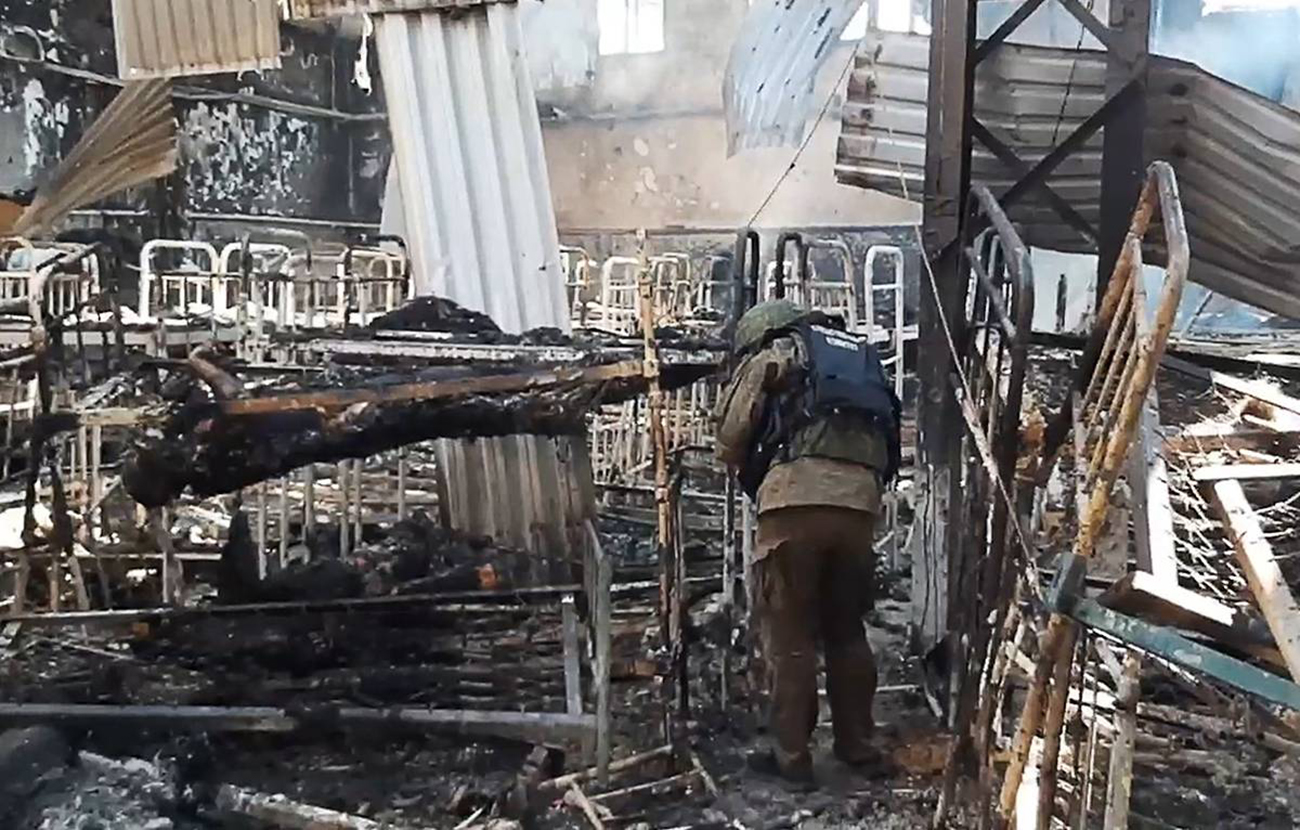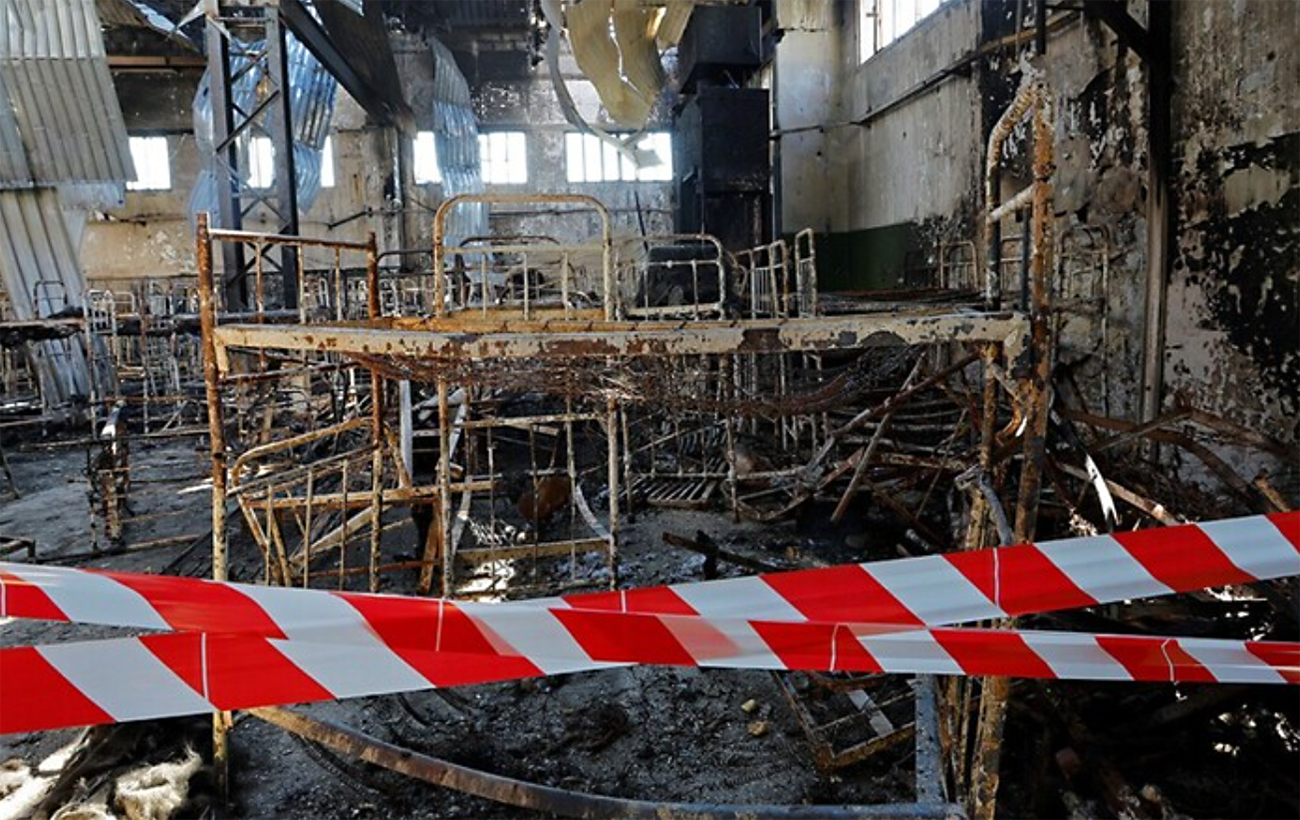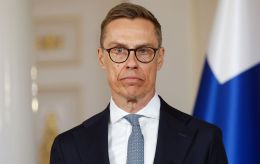Taken to execution by lists - Terrorist attack in Olenivka a year after the tragedy
 The terrorist attack in Olenivka became unprecedented in history (Photo: Vitalii Nosach, RBC-Ukraine)
The terrorist attack in Olenivka became unprecedented in history (Photo: Vitalii Nosach, RBC-Ukraine)
What happened within the walls of the Olenivka prison barracks, where the terrorist attack took place, was recreated by RBC-Ukraine through the stories of three families of prisoners of war.
When the defenders of Mariupol were leaving Azovstal, a wave of hope flew among everyone: maybe, I will return home alive. These thoughts were shattered by a thermobaric weapon with which the Russians struck directly at the barracks with prisoners. At least 57 soldiers were killed, and the world witnessed a tragedy called the "Olenivka attack." RBC-Ukraine tried to figure out how it happened, what was established during a year of investigation, and what was the reaction of international organizations.
Way to Olenivka
On that day, the command at Azovstal gathered the soldiers to deliver the main news: they were leaving their position and heading for evacuation. They used this word specifically to emphasize the significance of months of resistance while being surrounded. The defenders of Mariupol were, in reality, walking into captivity, both in terms of conditions and treatment. They went from the plant to the bridge, and from there, they took a bus to Olenivka.
The military was leaving a place where they had already bid farewell to life. Sergeant of the Azov battalion, Serhii Aleksievych, was already in Olenivka when the defenders began to leave the plant. His wife, Maria, says she had no idea about the evacuation until she saw the news on the media.
"They called it an evacuation, and I didn't know if Serhii had also left. Only on May 19th, I saw a video of my husband on Russian media. It was footage of an international representation of the Red Cross organization. Other servicemen were leaving Azovstal, and on that video, I recognized my husband," she shares.

Photo: Russians staged a terrorist attack in Olenivka (screenshot from the video of Russian media)
Serhii ended up in captivity earlier, on May 16th, before all the other soldiers left, as he was injured during the battle in Mariupol. That's why they transferred him to provide medical assistance.
"His fellow soldiers who were already released from captivity told me that he had a bullet stuck in his bone, and they couldn't remove it at Azovstal hospital. So, most likely, he still walks around with the bullet in his bone," the woman says.
Maria last saw her husband in a video by the occupiers in June when the Russians showed servicemen who were held in Olenivka. When the attack happened, she was mostly concerned about him not being at the epicenter of the tragic events that occurred.
Hanna, a representative of the Union of Families of the Olenivka Attack Victims, says that one of the soldiers who returned as part of the exchange told them that guards came with lists of soldiers who were to be moved to specific barracks.
"They tell us that the crime was planned, and the people were random. However, we still believe that if they came with lists, perhaps the people were selected intentionally. This needs to be clarified by the investigation," she says.
Terrorist attack
Military personnel were brought to a prison that is under the occupation of Russian forces. The conditions were harsh, and the treatment was corresponding. On July 29, the barracks, which had been converted from an industrial zone into a residential one, were already filled with prisoners of war. The guard post was moved farther away, and, furthermore, they dug a fortified trench for them, which raised questions. A day before that, the guards were given body armor and helmets, which were not provided in other barracks.
On the night of July 29 to July 30, the first explosion occurred outside the prison's territory. Not everyone heard it. Some woke up, checked that everything was fine, and went back to sleep. However, at around 11:30 PM, there was an explosion inside the barracks near the entrance doors.

Photo: Russians tried to blame the attack on Ukraine (screenshot from the video of Russian media)
The Grad MLRS, which was located near their barracks and near the prison's fence, fired in the western direction away from the prison just before the incident, masking the sounds of the explosions that killed and injured people in the barracks. The prisoners of war were ordered to clear the rubble and remove the bodies of the deceased and were instructed not to speak about what they had witnessed. Many soldiers bled profusely, and they were not given timely medical assistance. Slightly injured soldiers who were witnesses were thrown into isolation cells.
The Russian side claimed that they had supposedly been "struck" by the American M142 HIMARS system. However, the Ukrainian investigation revealed that the killing was done with thermobaric weapons inside the building. The world witnessed an unprecedented act of cruelty in a military context.
Soldier Ihor Prokopenko was in the barracks at the time of the explosion. His sister Ksenia told the media that on July 30, the Russians released lists of the deceased, where she saw her brother's surname and first name. That was all the information available at the time. Ukrainian intelligence could not comment on it.
The Azov battalion's support service created a chat group for the families of those people who presumably died during the attack. That list was the only information available. It was only on October 10 that the girl received the main confirmation - the bodies of the deceased soldiers were returned to Ukraine. The DNA analysis process began, which lasted for several months.
"You can't recognize the body; everything is burned. That's why we want to do a repeat DNA test. We want to involve an international commission on missing persons. But we haven't received permission from the Security Service of Ukraine or the investigator handling this case. And the body has not been taken yet," the soldier's sister tells RBC-Ukraine.
 Ksenia understands that international organizations were not ready for such an event. However, according to her, the UN mission could have done more instead of immediately dissolving its mission due to a lack of access to the explosion site.
Ksenia understands that international organizations were not ready for such an event. However, according to her, the UN mission could have done more instead of immediately dissolving its mission due to a lack of access to the explosion site.
"They can examine the bodies handed over to Ukraine, they can interview witnesses, gather information. I see that the mechanisms of such a large structure like the UN need improvement. Because it turns out that the Russians can do anything they want, and there will be no consequences. The guilty are not punished, there is no investigation. There is also no day of mourning for the deceased and no day of remembrance. Ukraine has not yet established these dates," the woman notes.
Struggle for accountability
The vast majority of women whose husbands ended up in captivity today live in conditions of partial or complete uncertainty. The wife of Azov member Serhii Aleksievych Oleksandra does not know where her husband is today. All she has is hope that he is alive.
"I try to hope for the best and do everything that needs to be done now, which can be done, which is to go to the media, talk about my husband, about the terrorist attack in Olenivka, about the soldiers who have been held captive in Russia for over a year, who are not being exchanged. We need to talk about this, and I am doing it," she says.
At the end of September, Oleksandra received a call from Serhii's comrade. He told her that her husband was injured during the terrorist attack. He was kept in the hospital, but whether he was treated or not is unknown. After the hospital, her husband was taken back to captivity, to the same prison. At the end of September, Serhii was taken away. Oleksandra suspects - to Russia, but she doesn't know exactly where.
"It is incredibly difficult to find information about your loved ones who are in captivity now because the Azov battalion is unfortunately isolated from other captives, so I am waiting, waiting for further developments, waiting for exchanges, waiting for my husband to return," the woman adds.

Photo: families of the victims in the terrorist attack raise questions at all levels (Vitalii Nosach, RBC-Ukraine)
The wife of one of the captured servicemen, Hanna, hoped that the UN mission would help free her husband from captivity, or after the terrorist attack, he and other servicemen would be taken to a third country for treatment. But nothing happened - even after the obvious murder of prisoners, the third party did not intervene, at least not with the intensity required by the situation.
"There was hope that the UN mission would come, that they would take them to a third country for treatment. After what they had been through. How people were screaming, crying for help, how his friends were burning. But nothing is happening... This UN mission is being disbanded," Hanna explains.
While international organizations unsuccessfully tried to gain access to Olenivka, collect data, and refute the Russian propaganda's claims that HIMARS missiles struck the prison, the soldiers' relatives sought their own ways. For example, Oleksandra found like-minded people, joined forces and started knocking on every available door.
Initially, it was an initiative regarding the release of prisoners, primarily wounded soldiers, who, according to the Geneva Conventions, should be exchanged first and unconditionally. However, the efforts did not yield the expected results, but in the group of relatives, Oleksandra found a woman whose husband was also in Olenivka.
She wrote to me about her idea of uniting people whose relatives suffered from the terrorist attack in Olenivka. Of course, I supported this initiative, and she began searching for the affected families. We communicated constantly and tried to help each other. Eventually, we managed to gather a certain number of families," Maria shares.
On the other hand, Hanna initially approached the authorities, sending a letter to the Commissioner for Human Rights, Dmytro Lubinets. However, due to his busy schedule, they couldn't meet. They then had meetings with like-minded individuals, which grew into a larger gathering. They discussed plans and compiled the necessary lists.
"We started forming the lists ourselves and searching for witnesses. This led us to becoming an official public organization today. We continue to fight for the reinstatement of an international investigation in Ukraine. That would expedite the identification of the bodies. We keep fighting for the release of the prisoners. Over 60 people are still in captivity," emphasizes Hanna.
Oleksandra is battling a system with many blind spots, practically on the same front. Government representatives cannot answer all the questions, as the international investigation has been closed since January. The Ukrainian investigation is carried out secretly, although the relatives hope to eventually obtain information.
Today, Maria's group plans to travel abroad to explain to foreigners the importance of not forgetting about the Olenivka terrorist attack. Russian occupiers killed over 50 prisoners of war, violating internationally accepted norms and basic humanity. When asked where she finds her strength, Maria replies that when she feels down, she thinks of her husband.
"He went through an incredible ordeal. It was almost three months of defending Mariupol, completely surrounded, without proper food, medication, or rest, in dreadful conditions, in hell. And now, he's also enduring hell, 14 months in captivity, so in total, he has been surrounded by enemies for 17 months. I simply cannot give up; I have to keep fighting."
World's position
From August to October, Russia handed over the bodies of 57 people who died in the Olenivka terrorist attack. Many of them are difficult or practically impossible to identify. As of today, 47 bodies have been identified. The Prosecutor General's Office states that the investigation is ongoing, but they refrain from providing details to maintain its confidentiality.
Representatives of the International Committee of the Red Cross have repeatedly tried to reach Olenivka, but the Russian occupiers deny them access. At the same time, Kremlin propaganda continues to accuse the Ukrainian Armed Forces of killing the prisoners.
Immediately after the terrorist attack, the United Nations formed its mission for investigation. In January, they dissolved it because the Russians denied access to the site. Exposing the Kremlin's myth about HIMARS hitting the barracks, the UN added that the investigation must continue.
"The prisoners of war who were injured or died at Olenivka, and their family members, deserve the truth to be known, and for those responsible for breaches of international law to be held accountable," emphasizes UN High Commissioner for Human Rights, Volker Türk.
After the UN statement, several international analysts acknowledged that the explosions occurred inside the barracks. In expert circles, it is believed to be a positive sign – Ukraine's allied countries have exposed yet another Kremlin lie, and this crime, like many other crimes committed by the occupiers, will be investigated. However, it is still premature to speak of any significant changes in international structures or Ukrainian law enforcement investigations.

